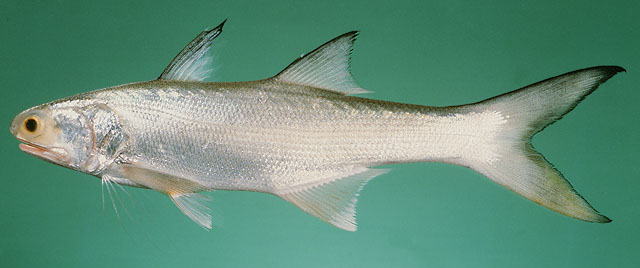| Polynemidae (Threadfins) |
| 200 cm TL (male/unsexed); max.weight: 145 kg |
|
pelagic-neritic; depth range 0 - 23 m, amphidromous |
| Indo-West Pacific: Persian Gulf to Papua New Guinea and northern Australia. Replaced by Eleutheronema rhadinum (Jordan & Evermann, 1902), in East Asia (Japan, China, Viet Nam). |
|
Dorsal spines (total): 9-9; Dorsal soft rays (total): 13-15; Anal spines: 3-3; Anal soft rays: 14-16. Pectoral filaments 4; fin membranes vivid yellow in life, except in large specimens, > ca 35 cm SL. Vomer with deciduous tooth plates on both sides, except in juveniles. Posterior part of maxilla deep, 3-4% of SL. Short tooth plate extension onto lateral surface of lower jaw. 7-9% SL (Ref. 41639). |
| Adults occur mainly over shallow muddy bottoms in coastal waters. Also enter rivers (Ref. 3479, 6390, 11230). Juveniles found in estuaries. During winter, adults ascend the rivers. They usually form loose schools, although larger fish are more often observed in pairs or singly (Ref. 6390). Feed on prawns and fish (largely members of Mugilidae, Engraulidae, and Sciaenidae) with occasional polychaetes. Frequency of crustaceans to fish in the diet varies seasonally. Larvae (7-30 mm TL) feed mainly on copepods and mysids but also take shrimps and prawn larvae (Ref. 57343). Juveniles (31-60 TL) feed on prawns shrimps and mysids (Ref. 57343). Protandrous hermaphrodites. Marketed fresh, frozen, and dried or salted. |
|
Not Evaluated
(Ref. 96402)
|
| harmless |
|
Source and more info: www.fishbase.org. For personal, classroom, and other internal use only. Not for publication.
Page created by Jen, 05.08.02,
php script by kbanasihan 06/09/2010 ,
last modified by
dsantos, 20/08/10

